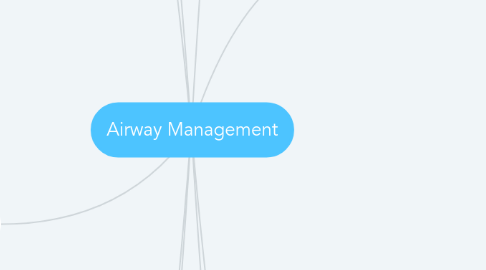
1. Oral Pharyngeal Airways
1.1. Used to create patent airway
1.2. Can stimulate coughing, vomiting, laryngospasm in semi-concious person
1.3. Gently insert in mouth to avoid injury
1.4. Improper placement worsens obstruction by forcing tongue backwards.
1.4.1. Too small:can cause tongue to kink
1.4.2. Too large: may cause obstruction by displacing epiglosttis posterior and traumatize larynx
1.4.3. Correct size estimated by holding airway next to patients mouth. Tip should rest cephalad to the angle of the mandible.
1.4.4. If airway repeatedly comes out of patients mouth, should be removed and use smaller.
2. Nasal Pharyngeal Airways
2.1. Less stimulating to patient
2.2. Epistaxis
2.2.1. Should not be used in anticoagulant patient
2.3. Contraindicated in patients with basilar skull fracture
3. LMA
3.1. Introduced in 1988
3.2. Supraglottic Airway Device
3.2.1. Alt to Face mask and ETT
3.2.1.1. Distal end LMA cuff lies with tip resting in inferior recess of hypopharynx immediately above esophageal sphincter
3.2.1.2. Sides face into pyriform tissues
3.2.1.3. upper border rests against base of tongue
3.2.2. Frequently used to maintain patent airway and administer anesthetic gases.
3.2.2.1. Can be used to rescue airay in difficult airway situation.
3.2.3. Size Selections
3.2.3.1. Largest LMA Classic size appropriate for the patient to prevent overinflating cuff in an attempt to compensate for inadequate seal pressure.
3.3. Indications and Uses
3.3.1. Used in fasted, anesthestized, patients
3.3.2. Does not replace ETT bc it CANNOT reliably protect against aspiration of gastric contents.
3.3.3. Best suited for elective surgical cases where face masks can be used or tracheal intubation not necessary
3.3.3.1. Pressure control ventilation may be mode of choice bc it allows a lower peak pressure for same TV with less leak. (or can use CPAP)
3.3.4. also indicated in known or unexpected difficult airway.
3.4. Contraindications
3.4.1. Does not protect airway from effects of regurg aspiration!
3.4.2. Pt who have not fasted or cannot confirm fasting
3.4.3. Morbidly obese, pregnant
3.4.4. Multiple or massive surgery
3.4.5. acute abdominal or thoracic surgery
3.4.6. Any condition associated with delayed gastric emptying.
3.4.7. Pt with fixed or decrease in pulm compliance (pulm fibrosis)
3.4.8. Adult pt who are not able to understand instructions or can adequately answer questions on H&P.
3.5. Adverse effects
3.5.1. Vascular compression
3.5.1.1. blood vessels of tongue leading to tongue cyanosis
3.5.1.1.1. This happens when LMA not inserted deeply enough or cuff is overinflated
3.5.2. Lingual nerve compression
3.5.2.1. Branch of mandibular branch trigeminal nerve (V3)
3.5.3. Hypoglossal nerve decompression
3.5.3.1. supplies all intrinsic and all but one extrinsic muscles of tongue
3.5.4. Gastic aspiration
3.6. Removing LMA
3.6.1. Correctly placed LMA well tolerated until return of protective reflexes.
3.6.2. Closely monitor patient throughout recovery phase
3.6.3. Continuously administer o2, check that bite block is in place
3.6.4. Leave pt undisturbed until reflexes are restored
3.6.5. Deflate cuff and simultaneously remove LMA and bite block only when patient can open mouth on command.
3.6.5.1. If cuff deflated before effective swallowing and cough reflexes return, seretions in upper pharynx ay enter larynx provoking coughing or laryngospasm.
3.6.5.2. Verify airway patency.
4. Extubation
4.1. Suction pharynx prior to extubation
4.1.1. decreases risk for aspiration and laryngospasm
4.2. 100% 02
4.3. Untape ETT, deflate cuff, small amount of positive pressure on anesthesia bag.
5. Video Laryngoscopy
5.1. Called by various names of manufacter
5.1.1. Glydescope, Storz, McGrath
5.1.2. Allows views of more anteriorly placed airways
5.1.3. Requires less manipulation of cervical spine
5.1.4. Have replaced FOI as the go to difficult airway management.
6. Preoxygenation
6.1. aka Denitrogenation
6.1.1. Nitrogen vol is approx 69% functional residual volume (FRC)
6.2. Preox with 100% 02 with tight fitting mask.
6.2.1. 5 min allows up to 10 min reserve
6.3. No time? 4 vital capacity breaths of 100% 02 over 30 sec with tight mask.
6.3.1. will get to high pa02 (339mmHg) but quicker to desat than 5 min with 02
7. Face Mask Ventilation
7.1. Two things necessary:
7.1.1. Gas-tight mask fit
7.1.2. Patent airway
7.2. How to indicate incorrect technique
7.2.1. no compliance in anesthesia reservoir bag when AP: valve closed (sig leak around mask
7.2.2. High breathing circuit pressure with min chest movement and breath sounds.
7.2.2.1. Obstructed airway.
7.3. Predictors of difficult face mask vent:
7.3.1. Beard
7.3.2. Obstructive sleep apnea/ obese
7.3.3. no teeth (edentulous)
7.3.4. elderly (>55yr)
7.3.5. Stiff neck or compliance
7.3.6. Bones
7.4. Tips:
7.4.1. Avoid excessive pressure on submandibular area (obstructs airway)
7.4.2. Pressure to ventilate should not be greater than 20cm H20
7.4.3. Provide a volume of 6-7mL/kg (approx 500ml for average adult)
7.4.4. If patient has some ventilatory effort, assist their breaths watching closely for inspiratory efforts.
7.4.5. Vent with low pressures and low volumes to decrease gastric distention.
7.5. Complications with FMV:
7.5.1. Pressure on eye
7.5.1.1. corneal abrasions
7.5.1.2. retinal artery occlusion or blindness
7.5.2. excessive pressure on mandible
7.5.2.1. may damage mandibular branch of facial nerve (CNVII) with transient facial nerve palsy.
7.5.2.1.1. 5 Branches of facial nerve:
7.5.3. Pressure on mental nerves
7.5.3.1. branch of mandibular branch (V3) of CNV]
7.5.3.1.1. lower lip numbness
7.5.4. Positive pressure ventilation can force air into stomach instead of trachea (gastric distension)
7.5.5. Avoid mask ventilation on the following:
7.5.5.1. Nonfasted pt
7.5.5.2. morbid obese
7.5.5.3. GI obstruction
7.5.5.4. in trendelenberg pos
7.5.5.5. presence of trach fistula
7.5.5.6. massive oropharyngeal bleeding
8. Readiness for Extubation
8.1. Deep vs awake
8.2. recovery from neuromuscular block
8.3. signs of adequate recovery from block
8.4. light plane of anesthesia
8.4.1. Any reaction to suctioning = light plane
8.4.2. No reaction = deep plane.
8.5. eye opening or purposeful movement
8.6. coughing/ bucking ETT
8.6.1. Lidocaine IV 1.5mg/kg 1-2 min before suctioning and extubation
9. Laryngoscopes
9.1. Rigid scopes
9.1.1. Handle- grip and battery
9.1.2. various sizes
9.1.3. held in left hand
9.2. Blades
9.2.1. inserted into mouth
9.2.2. curved vs straight
9.2.3. various sizes
9.2.4. light source.

